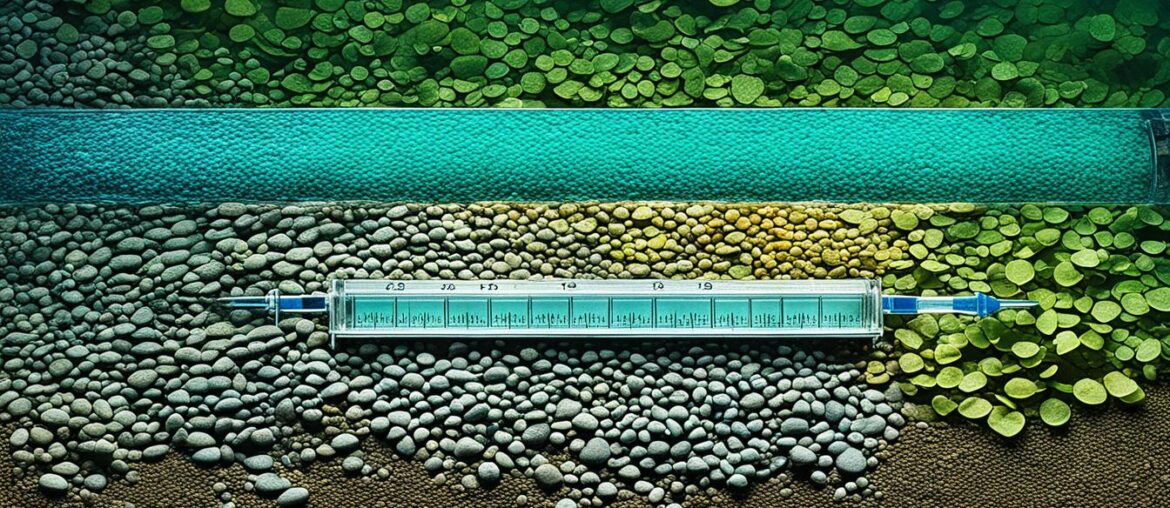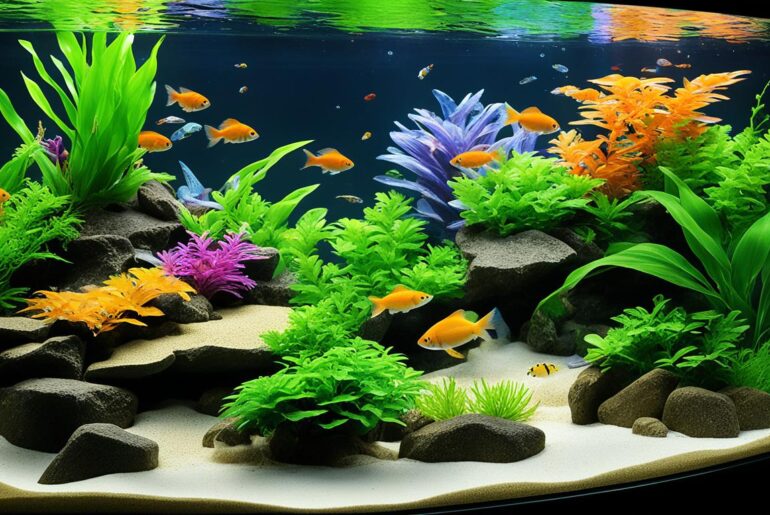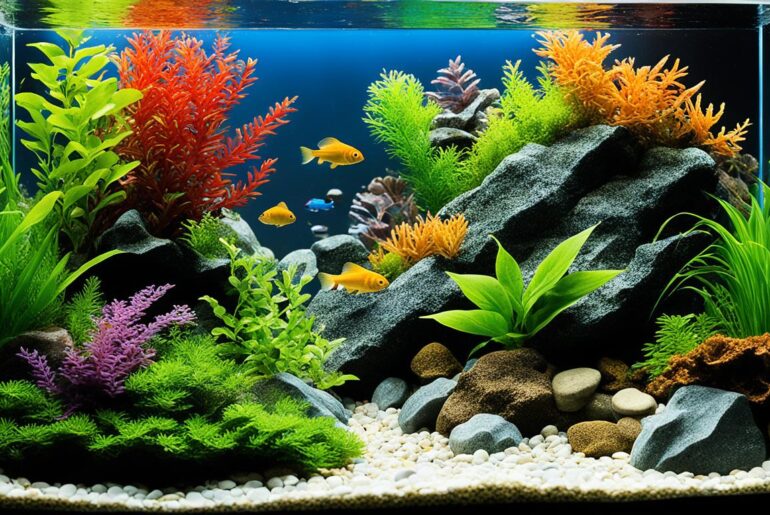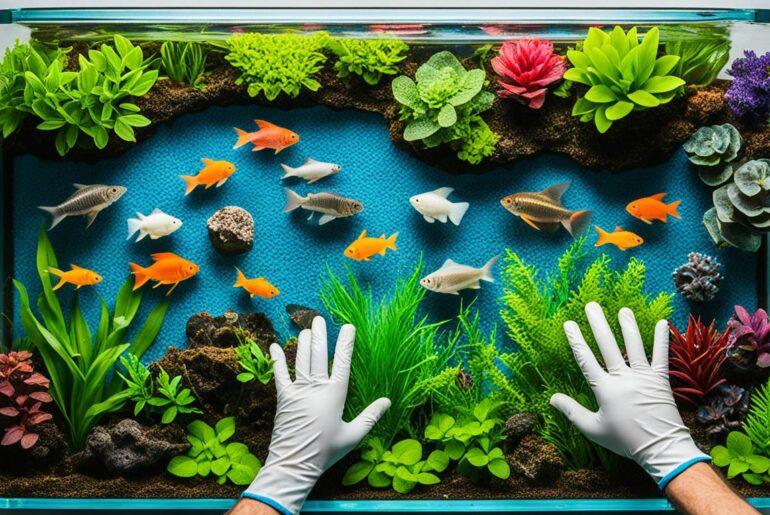Have you ever stared into the mesmerizing depths of a beautifully planted aquarium, wondering how it all comes together? I know I have. There’s something magical about the way the vibrant green plants sway in the water, providing a serene haven for colorful fish to call home.
But as captivating as these underwater landscapes may be, creating them is no easy feat. One of the challenges that every aquarist faces when planning a new freshwater tank is determining the right amount of substrate to use. It may seem like a minor detail, but getting it right is crucial for the health and success of your aquarium.
Don’t worry, though. I’ve been there, navigating the murky waters of substrate calculations, and I’m here to help guide you through it. Together, we’ll unravel the mysteries of calculating substrate quantity and ensure that your aquatic oasis thrives.
Key Takeaways:
- Calculating the right amount of substrate is essential for a healthy and visually appealing freshwater tank.
- Using an aquarium substrate calculator simplifies this process by providing accurate measurements and cost estimates.
- Factors such as substrate depth, type, and aquascaping preferences must be considered when determining the substrate quantity.
- There are various substrates available, each with unique characteristics and benefits.
- Proper preparation and maintenance of the substrate contribute to the long-term success of your aquarium.
Why Calculating Substrate Quantity is Important for Freshwater Tanks
Calculating the right amount of substrate for your freshwater tank is essential for several reasons. Firstly, it helps ensure that you have enough substrate to properly cover the bottom of your aquarium. This is important for providing a stable environment for your plants and fish.
Without adequate substrate coverage, your plants may struggle to establish their roots, leading to poor growth and instability. Fish also rely on a well-covered substrate to create natural habitats and foraging areas. Properly calculating substrate quantity ensures that every inch of your tank’s floor is functional and optimized for the well-being of its inhabitants.
Additionally, calculating substrate quantity can prevent wastage and save you money by avoiding unnecessary purchases. By determining the exact amount of substrate needed, you can avoid overstocking and reduce the likelihood of excess substrate sitting unused, taking up space, and potentially causing water quality issues.
Knowing the optimal substrate depth for your tank is also crucial. Different plants have varying requirements when it comes to root depth, and a well-calculated substrate depth will promote healthy plant growth. Plants with extensive root systems, such as Amazon swords or Vallisneria, may require a deeper substrate to fully establish themselves. On the other hand, mosses or carpeting plants may thrive with a shallower substrate depth.
In addition to facilitating plant growth, the appropriate substrate depth contributes to the overall aesthetic appeal of your tank. A well-calculated substrate can create visually pleasing contours and slopes that enhance the natural beauty of your aquatic landscape, making it a focal point in your home or office.
So, by taking the time to accurately calculate the substrate quantity for your freshwater tank, you can ensure a stable environment, prevent wastage, save money, promote healthy plant growth, and create a visually stunning aquarium.
Using an Aquarium Substrate Calculator
Calculating the quantity of substrate needed for your freshwater tank is made easy with the help of an aquarium substrate calculator. By following a few simple steps, you can determine the exact amount of substrate required for optimal plant growth and a visually appealing aquarium.
- Dimensions: Start by entering the dimensions of your tank, including the length, width, and desired substrate depth. This information will serve as the basis for the calculator’s calculations.
- Calculation: Once the dimensions are entered, the aquarium substrate calculator will calculate the volume of substrate needed based on these inputs. It takes into account the shape of your tank and calculates the quantity accordingly.
- Bag Recommendation: In addition to the volume, the calculator suggests the number of bags you need to purchase. This recommendation ensures you have enough substrate to cover the entire bottom of your aquarium.
- Cost Estimation: The aquarium substrate calculator goes a step further by estimating the total cost of the required amount. This allows you to plan your budget and make informed purchasing decisions.
- Customization: To make the calculation more accurate, you have the option to select the specific substrate you plan to use. You can update the fields for liters per bag and cost per bag if necessary, ensuring the calculator provides accurate results.
Using an aquarium substrate calculator takes the guesswork out of substrate quantity calculation. It streamlines the process and gives you peace of mind, knowing that you have the right amount of substrate for your freshwater tank.
Now that we know how to use an aquarium substrate calculator, let’s explore the factors to consider when determining the substrate quantity for your freshwater tank.
Factors to Consider When Determining Substrate Quantity
Calculating the right quantity of substrate for your freshwater tank requires careful consideration of several factors. By taking these factors into account, you can ensure that you have enough substrate to provide a stable environment for your plants and fish while avoiding wastage and unnecessary expenses.
1. Desired Depth of Substrate
The depth of the substrate is an important factor to consider when determining the quantity you will need. The ideal depth may vary depending on the scale of your tank and the specific needs of your plants. Some plants, such as carpeting plants, may require a deeper substrate for their roots to establish and spread effectively. On the other hand, if you plan on keeping fish that like to dig or burrow, a shallower substrate may be more suitable.
2. Type of Substrate
The type of substrate you choose for your freshwater tank will also impact the volume and cost per bag. Different substrates have varying densities, which will affect the amount you need to achieve your desired depth. For example, a fine sand substrate will require more bags compared to a coarser gravel substrate to achieve the same depth. Additionally, the cost per bag may vary depending on the brand and quality of the substrate.
3. Slope of the Substrate
If you plan on creating a slope in your tank, consider the depth of the substrate at different points along the slope. Visualize the midpoint of the slope and estimate the depth of the substrate at that point. This will help you determine the overall quantity of substrate needed to achieve the desired slope effect. Keep in mind that creating a significant slope may require more substrate compared to a level bottom tank.
By taking the desired depth, type of substrate, and slope into consideration, you can accurately calculate the quantity of substrate needed for your freshwater tank. This will ensure that you provide the ideal conditions for your plants and fish, promoting healthy growth and a visually pleasing aquarium aesthetic.
Different Substrates for Freshwater Tanks
When it comes to choosing the right substrate for your freshwater tank, there are various options available, each with its own set of advantages and disadvantages. It’s important to select a substrate that meets your specific needs and preferences. Here are some popular substrates for aquariums:
| Substrate | Advantages | Disadvantages |
|---|---|---|
| ADA Aqua Soil Amazonia | Rich in nutrients Promotes healthy plant growth Aids in buffering water parameters |
Can cause ammonia spikes initially Requires careful monitoring of water parameters |
| ADA Aqua Soil Amazonia II | Similar benefits to ADA Aqua Soil Amazonia Improved granule structure for easier planting |
May initially release tannins into the water Higher cost compared to other substrates |
| ADA Aqua Soil Amazonia Light | Lighter color for a contrasting appearance Provides necessary nutrients for plants |
May require additional fertilizer for heavy root feeders Higher cost compared to other substrates |
| Up Aqua AquaSand | Provides a natural look Does not affect water parameters Easy to clean and maintain |
Does not contain nutrients May need additional root tabs for plant growth |
| Seachem Flourite Black | Rich in iron and other essential minerals Does not alter water chemistry |
May be too lightweight for larger plants Requires thorough rinsing before use |
| Fluval Plant and Shrimp Stratum | Specifically designed for planted tanks Allows for easy root penetration and growth |
Can be dusty during initial setup Higher cost compared to other substrates |
| CaribSea Eco-Complete | Contains beneficial bacteria for a healthy tank Provides essential nutrients for plant growth |
May cause cloudiness during initial setup Requires rinsing before use |
It’s important to consider factors such as nutrient content, potential ammonia spikes, color, size, and cost when selecting a substrate for your freshwater tank. Remember to choose a substrate that suits the needs of your plants and fits your desired aesthetic.
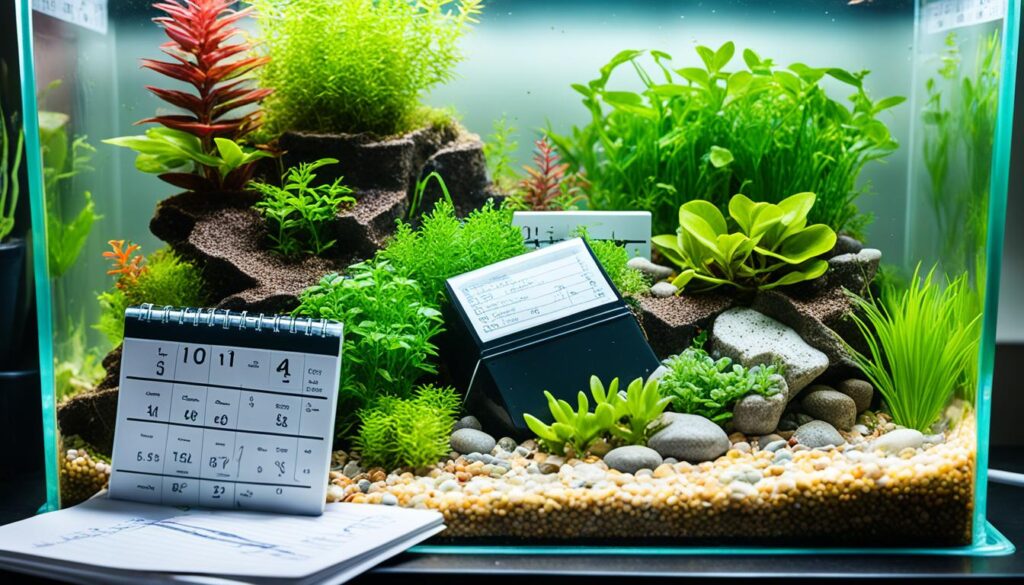
Note: The image above showcases a beautiful freshwater tank with carefully chosen substrate, creating a visually appealing and healthy aquatic environment.
Preparing the Substrate for Your Freshwater Tank
Before adding the substrate to your freshwater tank, it’s important to prepare it properly. This step ensures a clean and healthy environment for your plants and fish. If you’re using gravel or sand as your substrate, proper washing is recommended to remove any small particles or debris that can cloud the water and affect the water quality.
To wash the gravel or sand, you’ll need a dedicated bucket to avoid contamination from other chemicals or foreign matter. Fill the bucket with water and add the substrate. Use your hand or a clean tool to stir the substrate to agitate the particles and dislodge any dirt or debris. Then, carefully pour out the cloudy water while keeping the substrate in the bucket.
Repeat this washing process several times until the water runs clear, indicating that the substrate is clean and free from impurities. This may require multiple rounds of filling the bucket with water, stirring, and pouring out the cloudy water. Taking the time to thoroughly wash the gravel or sand will help maintain the clarity of your aquarium water and promote the overall health of your aquatic ecosystem.
If you’re using a complete substrate like ADA Aqua Soil, it’s important to follow the manufacturer’s instructions for preparation and use. Some complete substrates may require soaking or rinsing before they are ready to be added to your tank. Ensure you read and understand the instructions provided to maximize the benefits of the substrate.
Properly preparing the substrate for your freshwater tank is an essential step in creating a thriving aquarium. It removes debris and impurities, maintaining water clarity and promoting a healthy environment for your aquatic plants and fish.
Considerations for Aquascaping with Substrate
The choice of substrate plays a crucial role in aquascaping, as it affects the overall aesthetic of the tank. When selecting a substrate for your freshwater tank, it’s important to consider both the practical and visual aspects. Let’s explore some key considerations for aquascaping with substrate:
Color and Texture
Consider the color and texture of the substrate and how it complements the plants and fish in your tank. The right combination can create a visually stunning and harmonious environment. Dark substrates, such as black or deep brown, can make light-colored fish stand out and create a striking contrast. On the other hand, bright substrates, like white or light sand, can enhance the appearance of dark-colored fish and make them pop.
| Substrate Color | Effects on Fish Coloration |
|---|---|
| Dark substrate (e.g., black) | Light-colored fish stand out |
| Bright substrate (e.g., white) | Dark-colored fish appear more vibrant |
Arrangement and Depth
The arrangement and depth of the substrate can also significantly impact the visual appeal of your aquascape. For a natural look, consider arranging the substrate in a decreasing size pattern, with larger particles near the focal points and smaller gravel or sand along the edges. This creates a sense of depth and visual interest. Experiment with different arrangements to find the one that best suits your vision.
Plant Selection and Growth
Another factor to consider when choosing your substrate is the type of plants you intend to cultivate. Different plants have varying nutrient requirements, and certain substrates may provide better support for specific plant species. Research the needs of your chosen plants and select a substrate that can provide the necessary nutrients for their optimal growth.
By carefully considering the color, texture, arrangement, and depth of the substrate, you can create an aquascape that showcases the natural beauty of your plants and complements the appearance of your fish. Aquascaping is a true art form, and the substrate serves as the canvas upon which you create your masterpiece.
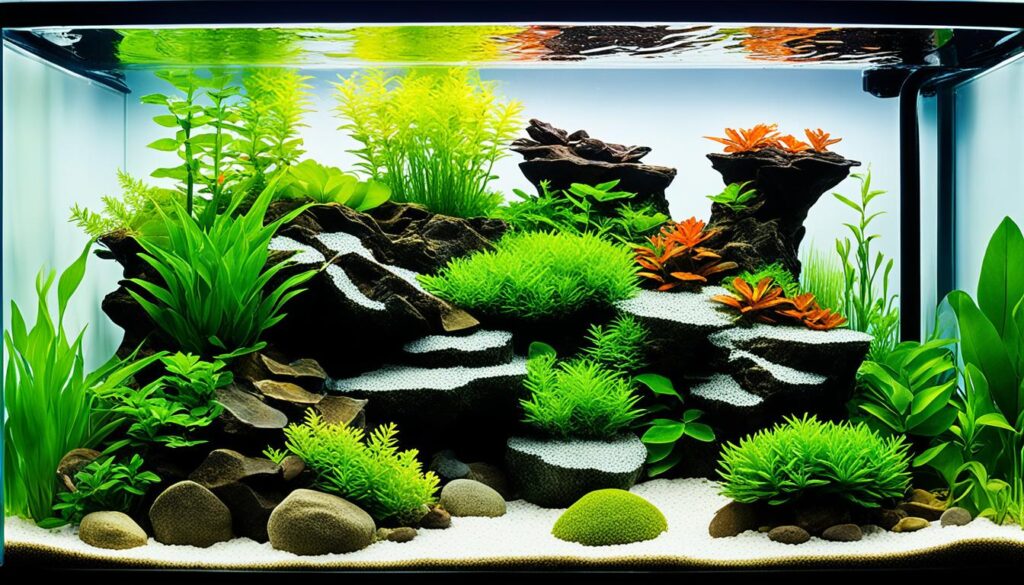
Maintaining and Changing Substrate
Once the substrate is in place, it’s crucial to prioritize its maintenance to ensure the ongoing health and vitality of your aquarium. Regularly vacuuming the surface of the substrate helps remove accumulated debris and waste, keeping the tank clean and the water quality pristine.
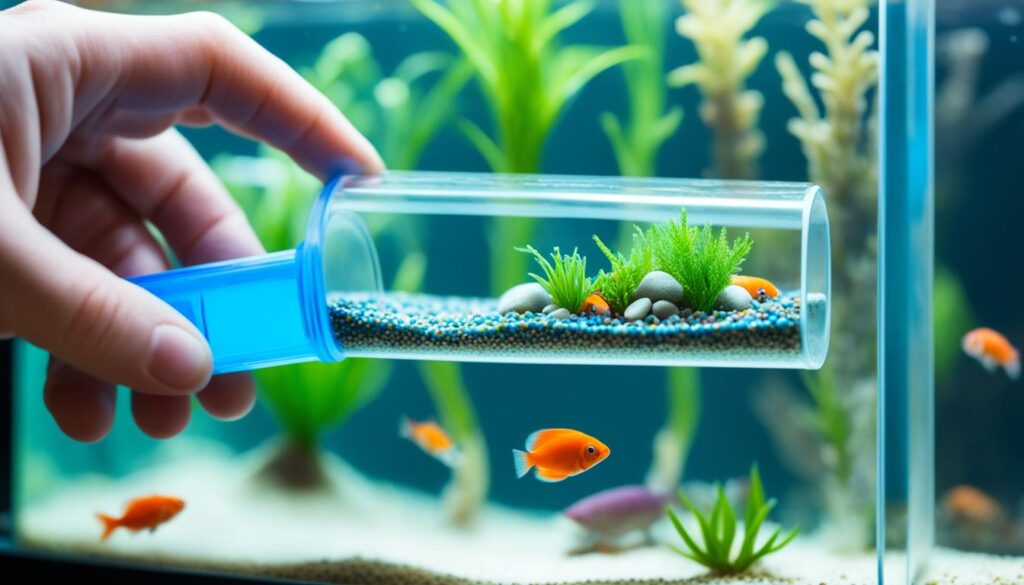
Over time, certain types of substrates, like the ADA Aqua Soil, may gradually lose their nutrient content and effectiveness. When this occurs, it becomes necessary to change the substrate to provide a fresh supply of nutrients for your plants. While changing the substrate can be a time-consuming process, it is vital for the long-term success of your aquarium.
When changing the substrate, it’s important to follow the manufacturer’s instructions and adhere to best practices to minimize disruption to the tank’s delicate ecosystem. This includes carefully removing the existing substrate, cleaning the tank thoroughly, and introducing the new substrate with precision and care. By taking these precautions, you can ensure a smooth transition and provide your plants with the nourishment they need for optimal growth.
To make the process of changing substrate more manageable and efficient, plan ahead and allocate sufficient time. It’s also important to ensure you have all the necessary equipment and materials readily available. By doing so, you can minimize stress and potential complications during the substrate replacement process.
In conclusion, maintaining and changing the substrate in your freshwater tank is a crucial aspect of aquarium ownership. By prioritizing regular maintenance and being mindful of the nutrient content of your substrate, you can create a thriving and visually stunning aquatic environment for your plants and fish to thrive.
Conclusion
Calculating the right quantity of substrate for your freshwater tank is a crucial step in creating a healthy and visually appealing aquarium. By using an aquarium substrate calculator, considering various factors, and selecting the appropriate type of substrate, you can ensure optimal conditions for your plants and fish.
Proper preparation and maintenance of the substrate are also key to the long-term success of your aquarium. Thoroughly washing gravel or sand substrates removes debris and ensures clear water, while following the manufacturer’s instructions for complete substrates like ADA Aqua Soil is essential. Regular vacuuming of the substrate surface helps keep it clean and prevents the accumulation of waste.
Take the time to research and plan for your substrate needs, as the right quantity and type can make a significant difference in the health and aesthetics of your aquarium. Enjoy the rewards of a well-calculated substrate quantity as you create a thriving aquatic environment for your plants and fish.
FAQ
What is the importance of calculating substrate quantity for freshwater tanks?
Calculating the right amount of substrate helps provide a stable environment for plants and fish, prevents wastage and saves money, promotes healthy plant growth, and creates an appealing aesthetic.
How do I use an aquarium substrate calculator?
To use an aquarium substrate calculator, enter the dimensions of your tank and desired substrate depth. The calculator will determine the volume of substrate needed, suggest the number of bags, and estimate the total cost.
What factors should I consider when determining substrate quantity?
Important factors include the desired substrate depth, the type of substrate chosen, and the slope of the substrate if creating a slope in the tank.
What are some different substrates available for freshwater tanks?
Popular options include ADA Aqua Soil Amazonia, Up Aqua AquaSand, Seachem Flourite Black, Fluval Plant and Shrimp Stratum, and CaribSea Eco-Complete. Each substrate has its own advantages and disadvantages.
How do I prepare the substrate for my freshwater tank?
For gravel and sand substrates, thoroughly wash them to remove small particles and debris. Complete substrates should be prepared according to the manufacturer’s instructions.
What should I consider when aquascaping with substrate?
Consider the color and texture of the substrate, how it complements the plants and fish in your tank, and create depth and visual interest by arranging the substrate in a decreasing size pattern.
How do I maintain and change the substrate?
Regularly vacuum the substrate surface to remove debris. Complete substrates may need to be changed over time to replace lost nutrients. Follow the manufacturer’s instructions and best practices for changing the substrate.
Can you provide a brief summary of calculating substrate quantity for freshwater tanks?
Calculating substrate quantity is crucial for a healthy and visually appealing aquarium. Use an aquarium substrate calculator, consider various factors, choose the appropriate substrate, prepare it properly, and maintain it regularly for long-term success.
